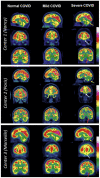Neurological and Psychiatric Manifestations of Long COVID-19 and Their [18F]FDG PET Findings: A Review
- PMID: 37510097
- PMCID: PMC10378471
- DOI: 10.3390/diagnostics13142353
Neurological and Psychiatric Manifestations of Long COVID-19 and Their [18F]FDG PET Findings: A Review
Abstract
For more than two years, lingering sequalae of COVID-19 have been extensively investigated. Approximately 10% of individuals infected by COVID-19 have been found to experience long-term symptoms termed "long COVID-19". The neurological and psychiatric manifestations of long COVID-19 are of particular concern. While pathogenesis remains unclear, emerging imaging studies have begun to better elucidate certain pathological manifestation. Of specific interest is imaging with [18F]FDG PET which directly reflects cellular glycolysis often linked to metabolic and inflammatory processes. Seeking to understand the molecular basis of neurological features of long COVID-19, this review encompasses the most recent [18F]FDG PET literature in this area.
Keywords: COVID-19; PET; [18F]FDG; long COVID-19; neurologic; positron emission tomography; psychiatric.
Conflict of interest statement
The authors declare no conflict of interest.
Figures







References
Publication types
Grants and funding
LinkOut - more resources
Full Text Sources

